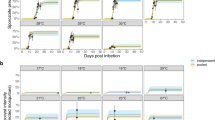Abstract
As a rule, dispersion of the Curvularia and Helminthosporia, two related groups of fungi, is accomplished principally by means of conidia, although ascospores have been shown to be important for the dissemination of a few species, such as Drechslera bromi (Died.) Shoem.1. The manner in which the conidia spread is of interest in the examination of epidemiology of plant diseases.
This is a preview of subscription content, access via your institution
Access options
Subscribe to this journal
Receive 51 print issues and online access
$199.00 per year
only $3.90 per issue
Buy this article
- Purchase on Springer Link
- Instant access to full article PDF
Prices may be subject to local taxes which are calculated during checkout
Similar content being viewed by others
References
Chamberlain, D. W., and Allison, J. L., Phytopath., 35, 241 (1945).
Meredith, D. S., Ann. Bot., N.S., 27, 39 (1963).
Luttrell, E. S., U.S. Dept. Agric. Plant Dis. Rep., 40, 57 (1956).
Meredith, D. S., Trans. Brit. Mycol. Soc., 46, 201 (1963).
Drechsler, C., J. Agric. Res., 24, 641 (1923).
Author information
Authors and Affiliations
Rights and permissions
About this article
Cite this article
KENNETH, R. Conidial Release in some Helminthosporia. Nature 202, 1025–1026 (1964). https://doi.org/10.1038/2021025a0
Issue Date:
DOI: https://doi.org/10.1038/2021025a0
Comments
By submitting a comment you agree to abide by our Terms and Community Guidelines. If you find something abusive or that does not comply with our terms or guidelines please flag it as inappropriate.



